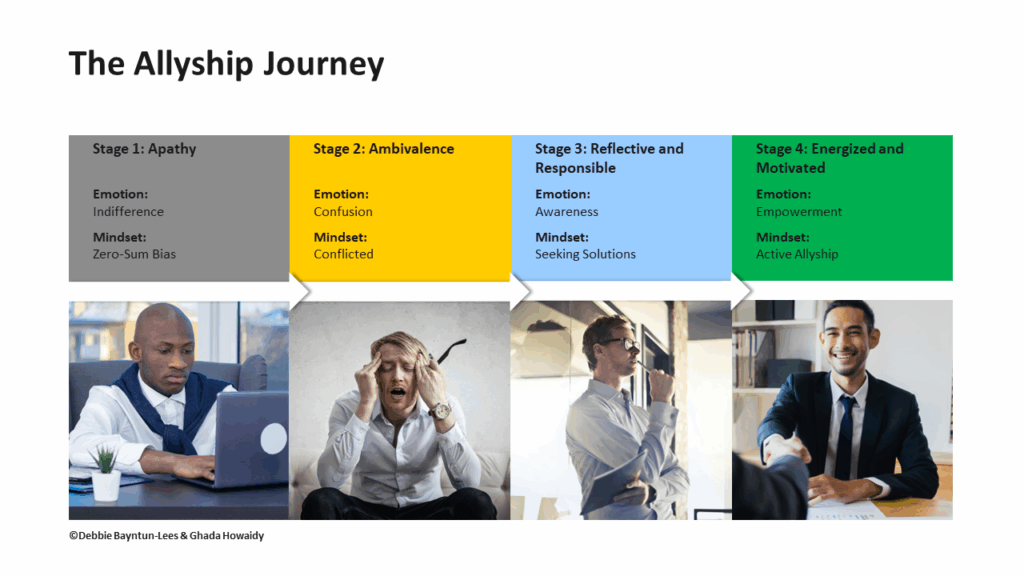Summary: Gender equity at work can’t succeed without men’s active involvement. New research from Hult International Business School reveals that men progress through four distinct stages towards becoming allies: apathy, ambivalence, reflective and energised. The study of over 500 male employees found that only one-third were aware of their company’s gender equity policies. Low engagement stems from uncertainty and cultural discomfort rather than outright resistance. For HR leaders, the key is creating supportive conditions that help men move through these stages authentically.
Despite decades of progress in gender equity, many workplace initiatives still miss a critical piece: meaningful engagement from men.
In our latest research at Hult International Business School, we set out to understand men’s experiences of gender equity efforts in their organisations, and what they need to become active, long-term allies.
Drawing on data from over 500 male employees across two global corporations, the study offers both cautionary insights and a practical path to systemic, sustainable change.
The message is clear. Equity cannot scale if men remain on the sidelines. Their engagement is not optional – it’s pivotal.
Four stages of allyship
Men’s engagement with gender equity isn’t a simple matter of being ‘for’ or ‘against’ it. Our findings surfaced a clear developmental pattern. We’ve called this pattern the Gender Equity Mindset Model.
This model maps four progressive stages men typically move through in their journey towards allyship:
- Apathy: Equity is seen as irrelevant or unnecessary. Emotion: indifference. Mindset: Zero-sum bias.
- Ambivalence. Awareness exists, but doubt and discomfort remain.
- Reflective and responsible – empathy and accountability begin to shape action.
- Energised and motivated – men become confident, visible advocates for change.
Each stage is influenced by personal reflection, emotional readiness, organisational culture and societal norms around masculinity. Critically, men shift between stages depending on the context and the support structures around them.
From an HR perspective, this model provides a framework for moving beyond generic inclusion initiatives. It enables targeted, meaningful interventions based on where individuals actually are in their journey.
Why male participation still lags behind
Across both organisations in our study, only one-third of men reported being aware of their company’s gender equity policies. Even fewer had engaged in related initiatives.
This low engagement wasn’t due to resistance alone. It stemmed from a mix of uncertainty, cultural discomfort and unclear expectations. Many men reported not knowing how to participate without ‘saying the wrong thing’ or being misinterpreted. Others described feeling excluded from conversations or unsure about whether their support was even welcome.
We also heard about entrenched masculine norms, like being ‘always available’ or hiding vulnerability. For some, this made allyship difficult to reconcile with organisational expectations. One respondent captured it poignantly:
“When I became a father, I realised that being on call 24/7 at work was not sustainable. But I didn’t feel I could say that out loud.”
These insights suggest a clear opportunity – to reshape workplace cultures so men can support equity in ways that feel authentic, not performative.
Why male allyship matters for HR professionals
For HR teams, the takeaway is not that we need more equity programmes. It’s that we must rethink how we frame and support allyship within existing structures.
It starts with asking different questions:
- Do men feel safe to explore their own biases and uncertainties?
- Are they offered ways to engage that acknowledge their own experiences of gender norms?
- Is allyship supported, modelled, and rewarded consistently across the organisation?
Our research points to several key enablers HR can lead on:
- Context-specific training: Move beyond generic DEI sessions. Use scenario-based workshops and reflective dialogue to explore the real-life dilemmas employees face.
- Peer mentoring and ally circles: Help men build confidence through shared learning and role modelling.
- Leadership visibility: Encourage senior leaders to demonstrate allyship through behaviour, not just messaging.
- Performance recognition: Ensure allyship efforts are recognised and reflected in development plans and promotion criteria.
These strategies are not drastic. But they do require a shift from transactional to relational change, which is core to our action research approach.
Listening to lived experience
While the data tells one story, the lived experiences of men in the study brought that story to life.
Many men described key turning points. For example, moments where a daughter, partner, colleague or female leader helped them see equity differently. That realisation often started close to home and then spread into the workplace.
As one participant shared:
“The watershed moment for me was realising it’s not enough to not be sexist. I need to engage and make a difference.”
Another added:
“Equity used to feel like someone else’s issue. Now I realise the kind of culture I want to work in depends on it.”
These moments of awareness, when supported well, become the foundation for lasting behavioural change.
How organisations can encourage male allyship
For organisations ready to meaningfully embed this work, the first step is to shift focus from who is an ally to what people need to become one.
The Gender Equity Mindset Model can be used as a diagnostic to help HR leaders identify and support each stage:

Apathy
- Emotion: Indifference
- Mindset: Zero-sum bias
- Action: Start with informal engagement tools like reflective stories or short-form content
Ambivalence
- Emotion: Confusion
- Mindset: Conflicted
- Action: Facilitate safe spaces to explore concerns and challenge assumptions
Reflective and responsible
- Emotion: Awareness
- Mindset: Seeking solutions
- Action: Provide structured pathways for learning and action
Energised and motivated
- Emotion: Empowerment
- Mindset: Active allyship
- Action: Offer leadership roles, visibility, and impact opportunities
Looking ahead
There’s a growing appetite among many men to show up differently, particularly when they’re allowed to do so without fear or defensiveness. But they need the right conditions.
The role of HR is not simply to deliver new programmes. It’s to create the emotional, relational and cultural scaffolding that allows equity to take root. That involves guidance, yes, but also listening, patience and purpose.
Our research suggests that men engage more meaningfully when they understand how gender equity connects to their own values, relationships and ambitions. When this happens, equity is no longer seen as an external demand, it becomes something shared.
That’s when real change begins!
Further resources
- #CallHimOut: Lewes FC gender equality campaign evolves to male allyship. Lewes Football Club’s men’s team publicly pledged to confront sexist behaviour and language. The team demonstrated how male role models can take responsibility for creating safer spaces for women through accountability and ongoing dialogue.
- Gender bias is the enemy of equal opportunity but here’s how mentoring can help. Mentoring programmes that disrupt traditional stereotypes can help organisations tackle gender bias. Reciprocal learning, multi-mentor approaches and increased participation of women as mentors can offset limiting beliefs.
- Progress or PR spin? Gender pay gap 2025 shows it’s still a man’s world, just with better reporting. While the UK’s median gender pay gap fell to 8.6%, 78% of companies still pay men more than women. HR leaders must move beyond compliance to drive meaningful change through salary audits, transparent pay structures and accountability at executive level.
- Empowering men: Bridging the learning gap for gender equity in the workplace. Research from Hult Ashridge reveals that whilst men recognise the importance of gender equity, many lack awareness of company policies and fear saying the wrong thing. Tailored training, safe spaces for dialogue and visible leadership modelling can transform hesitation into meaningful engagement.






